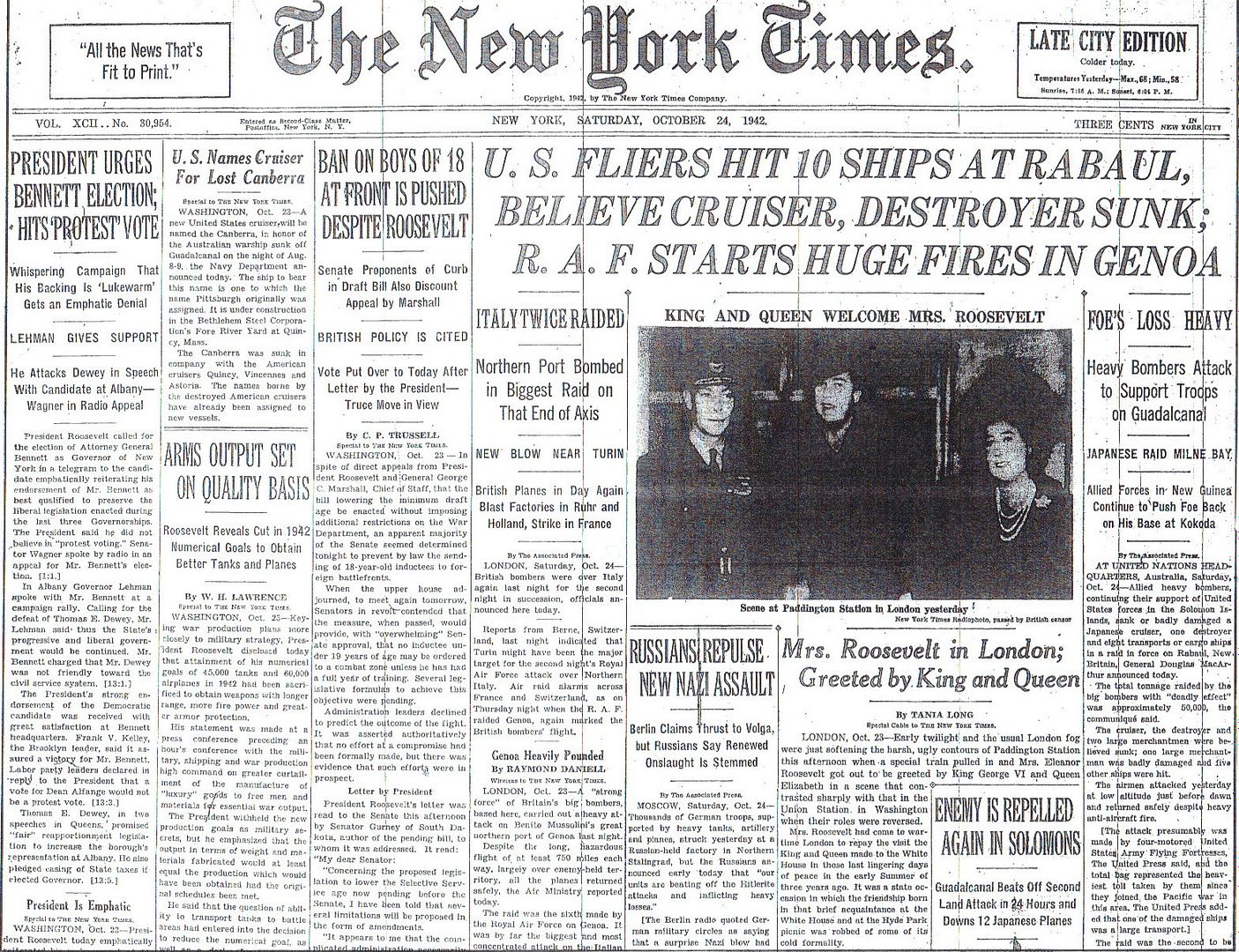
Posted on 10/24/2012 4:15:19 AM PDT by Homer_J_Simpson

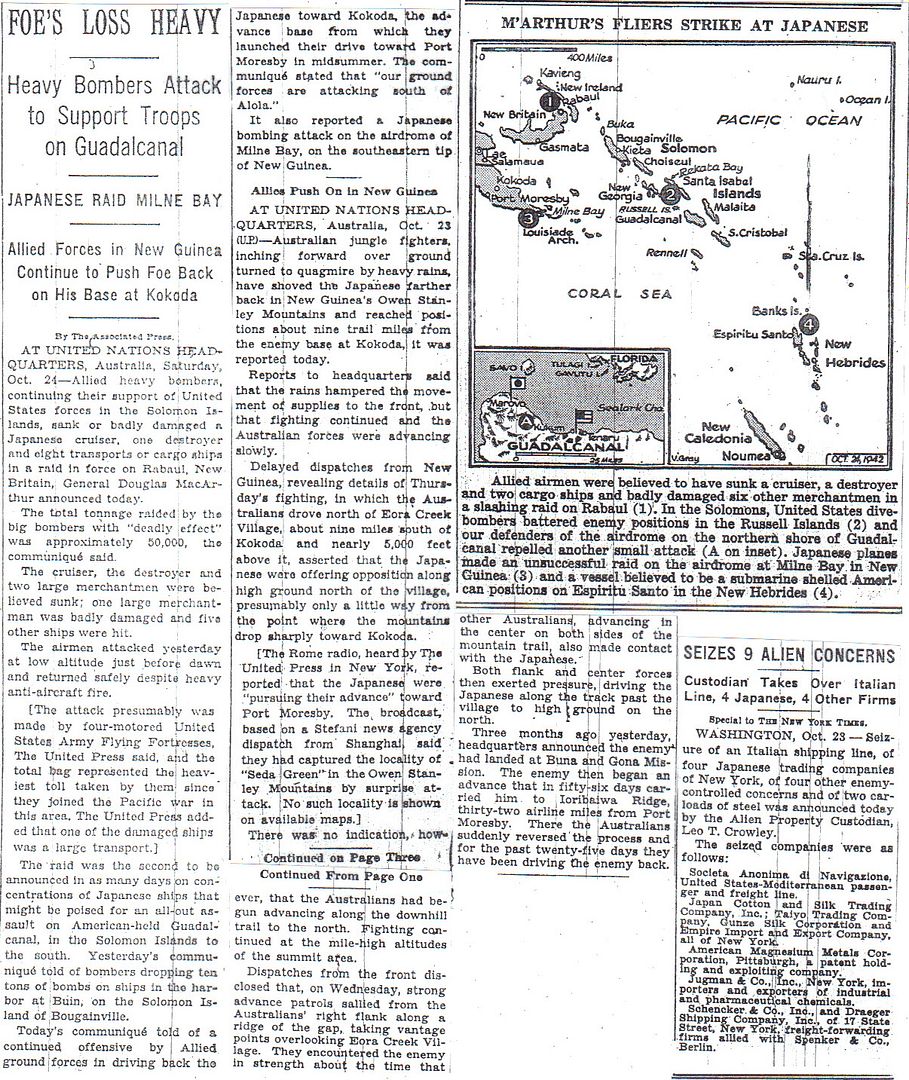
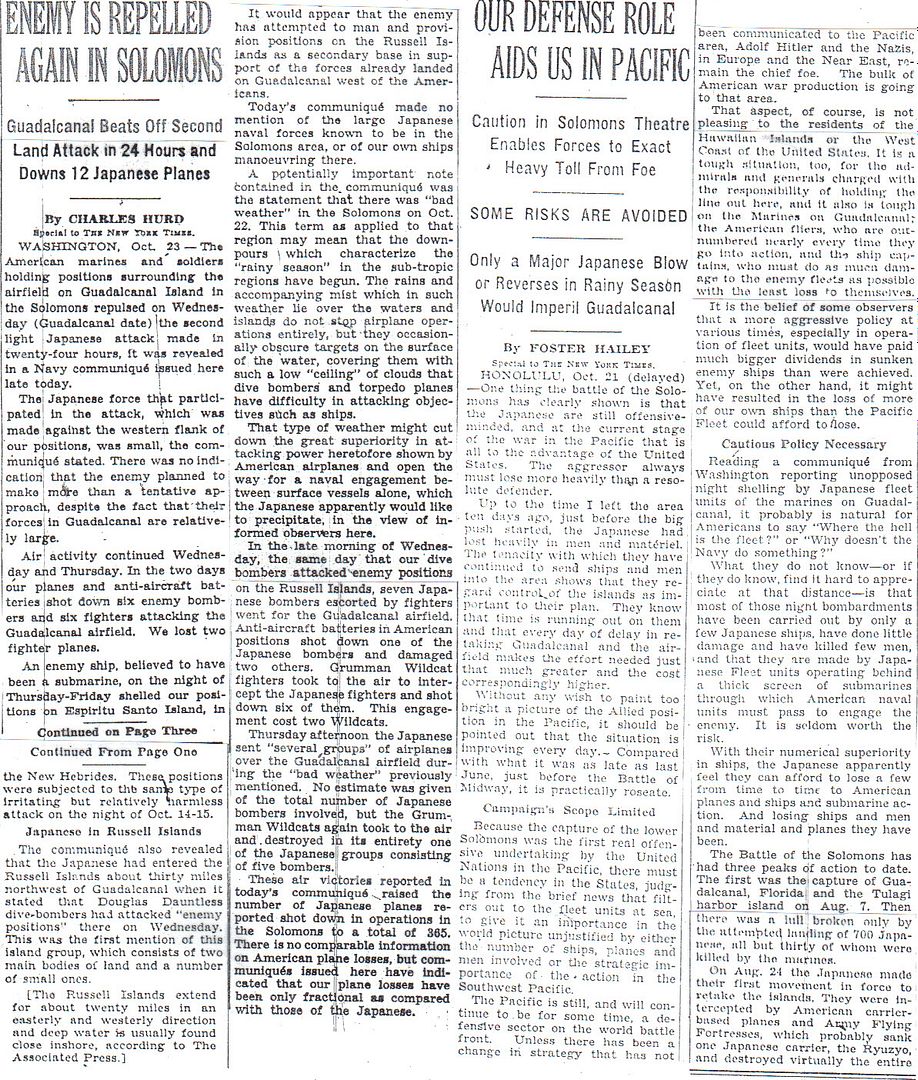
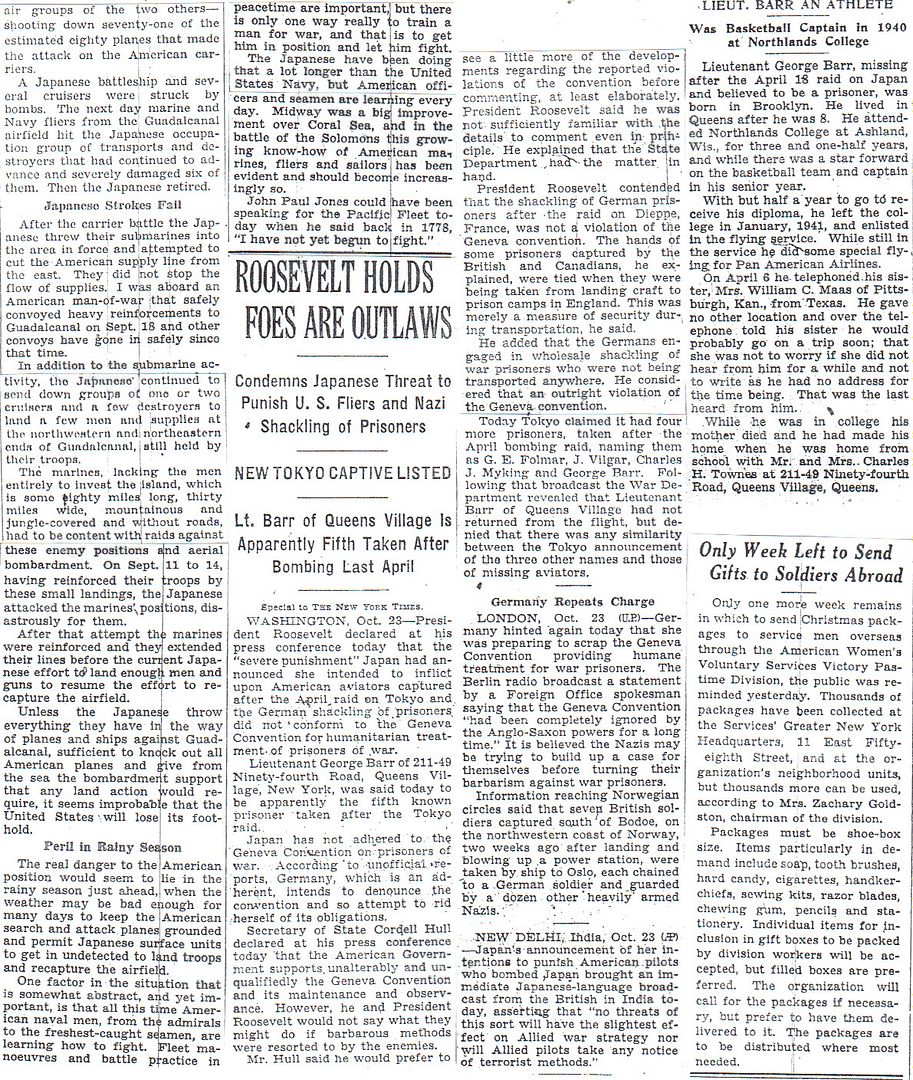
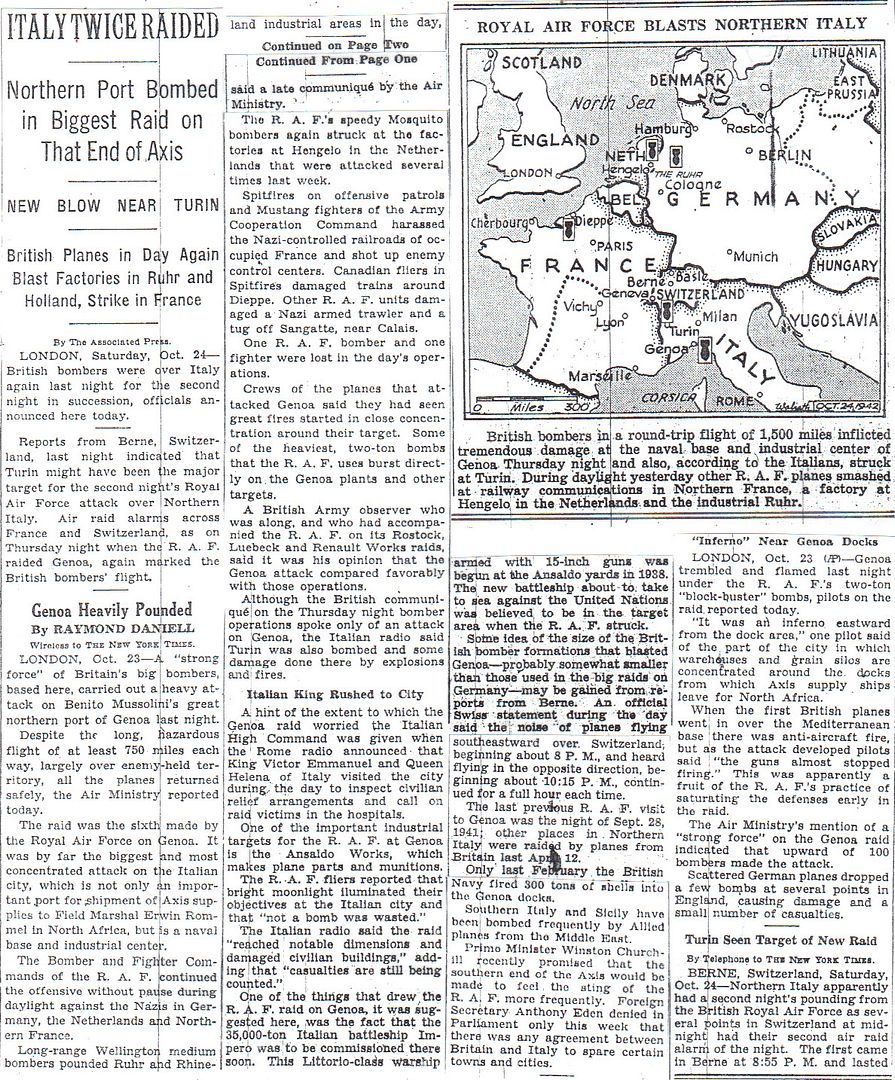
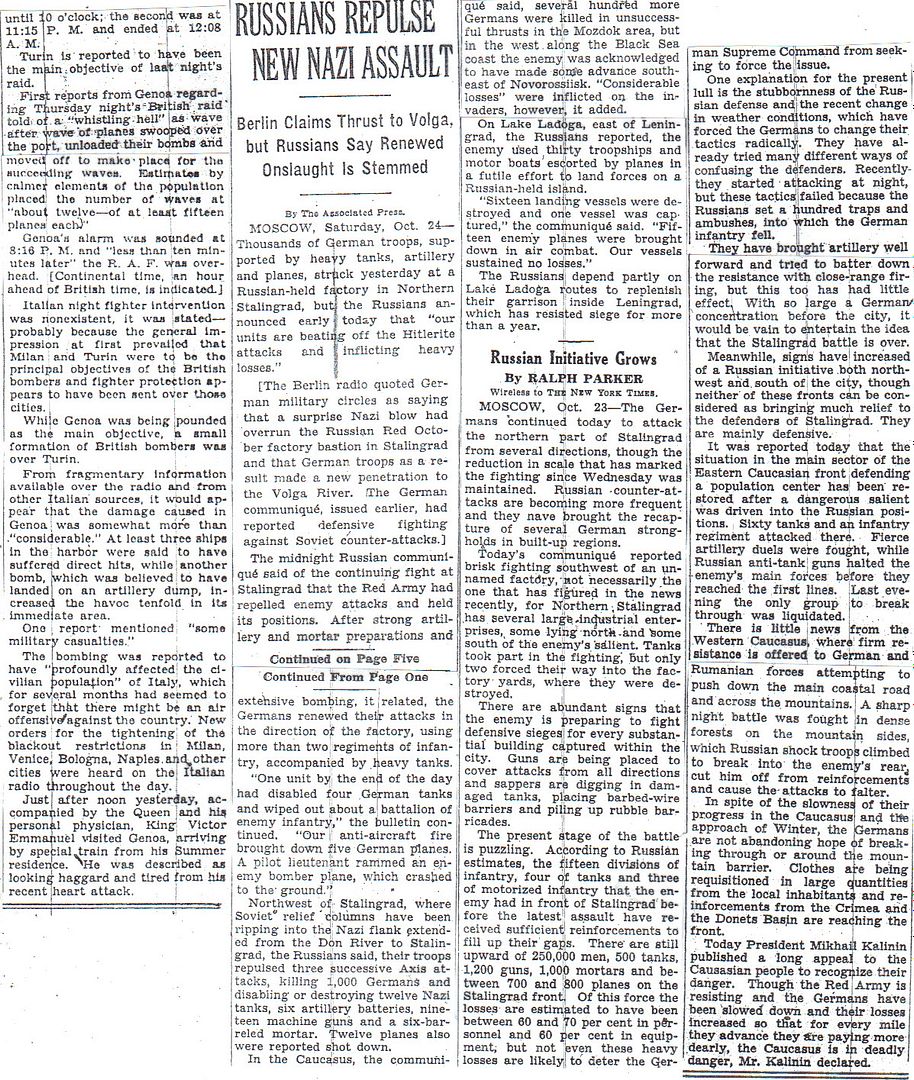
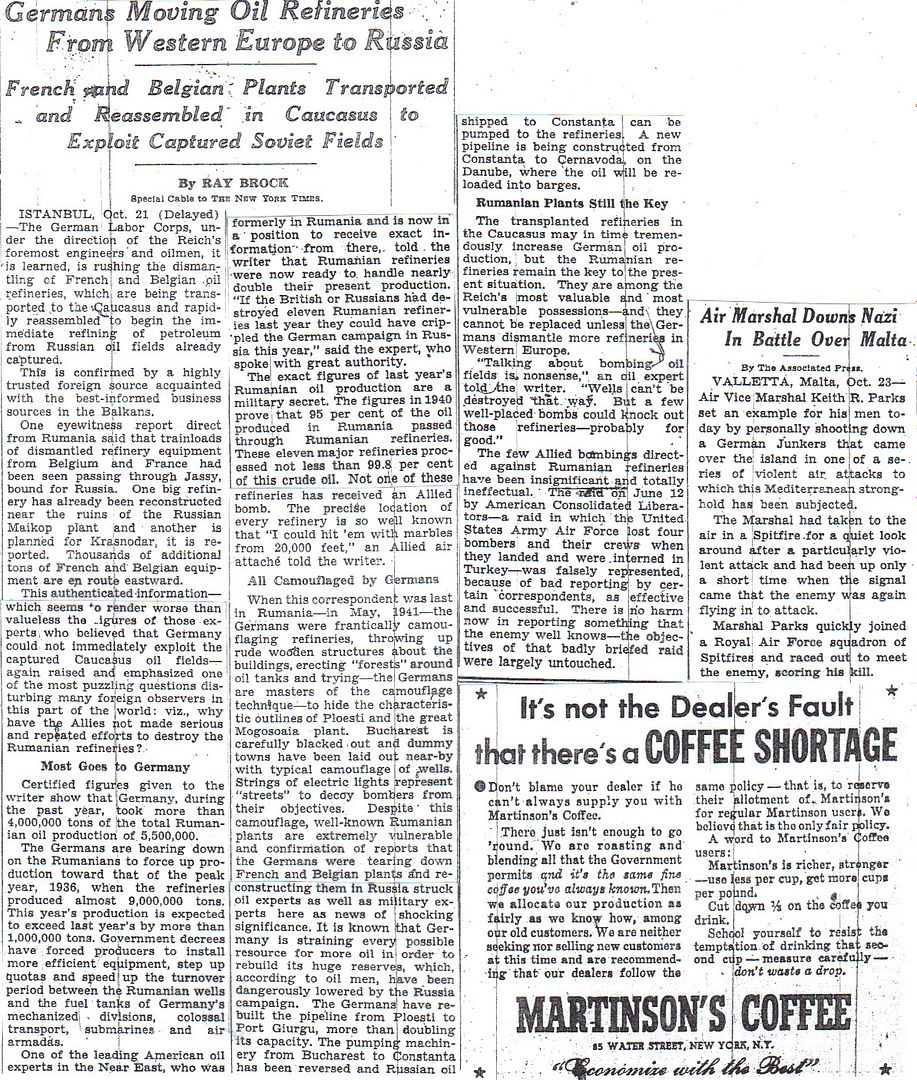
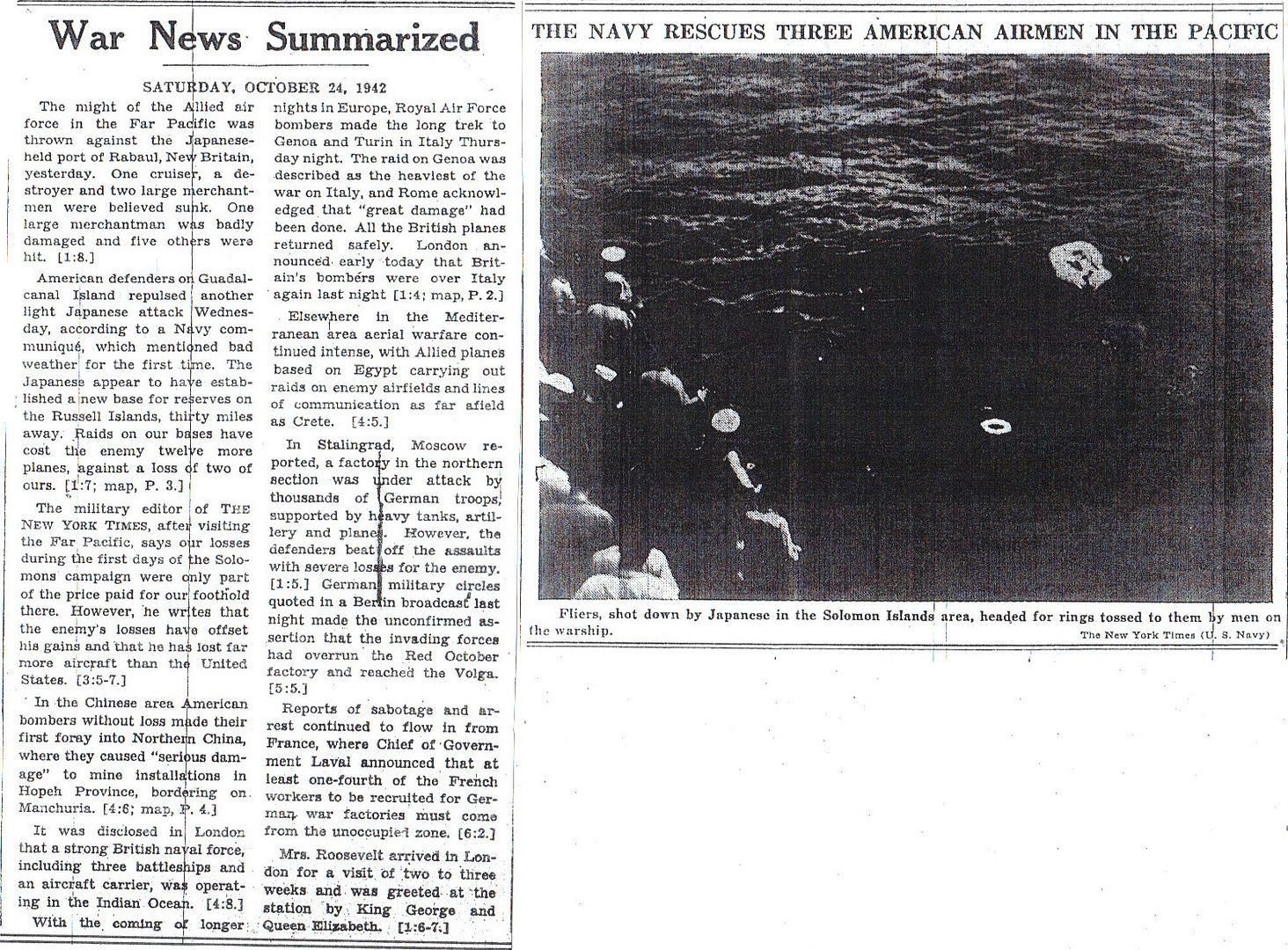
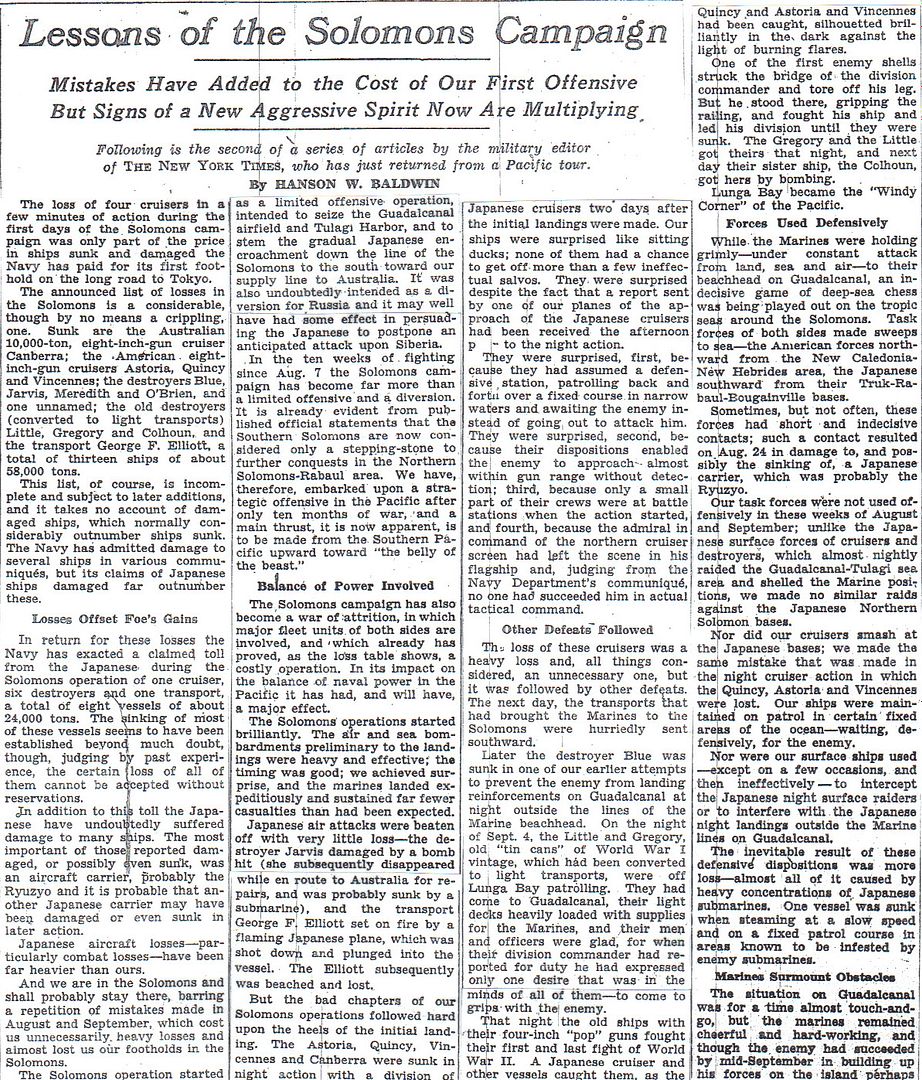
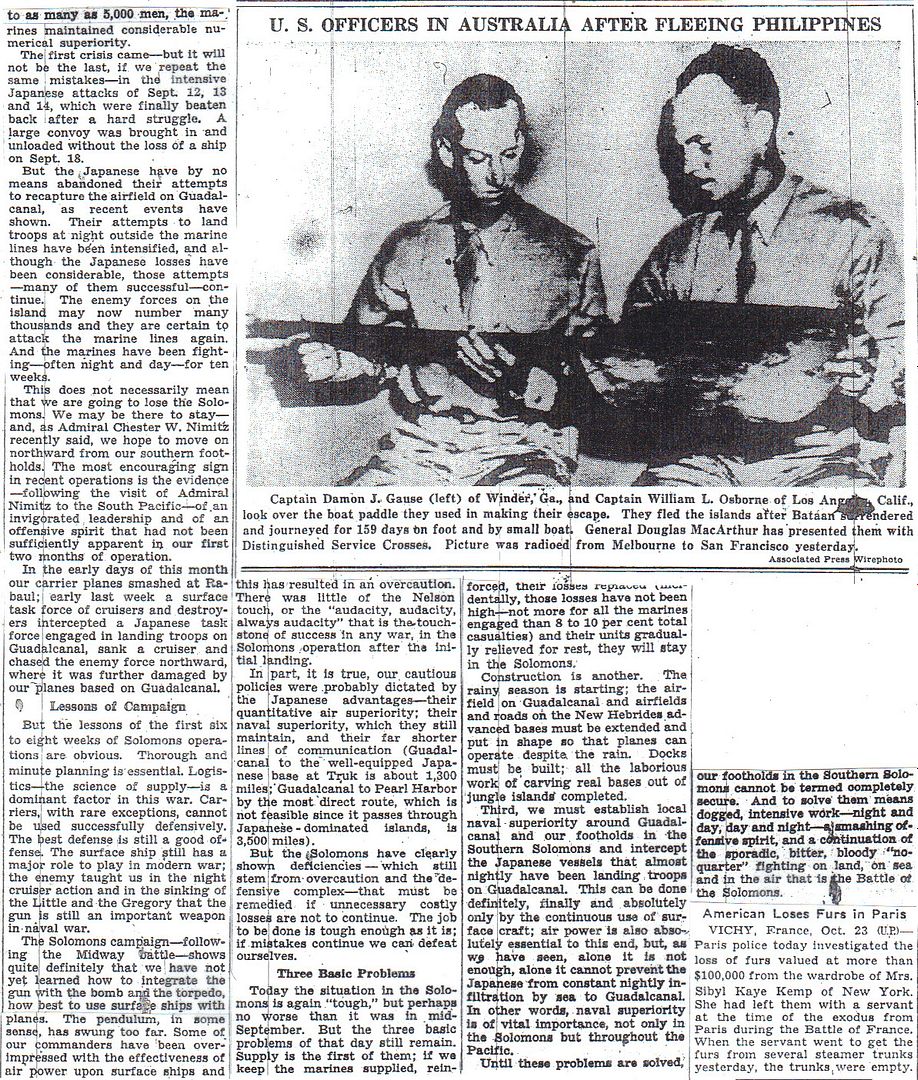
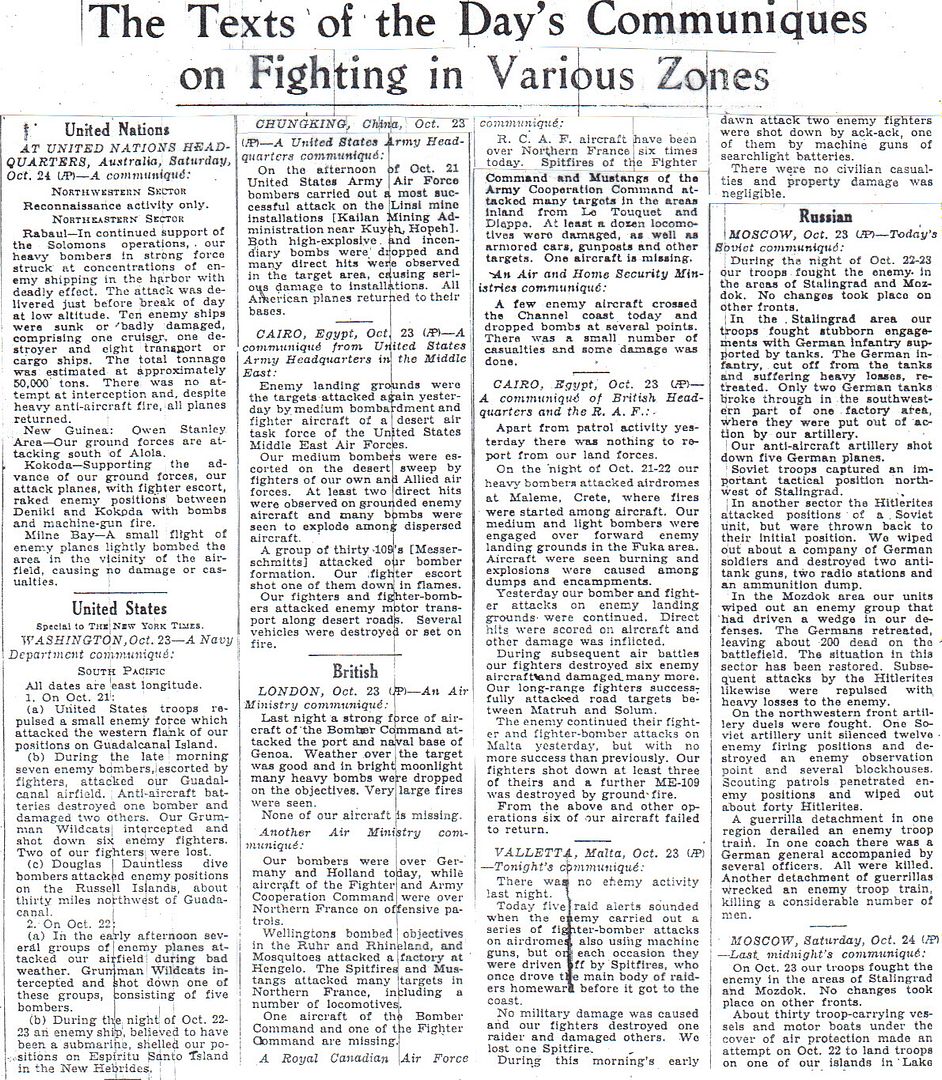
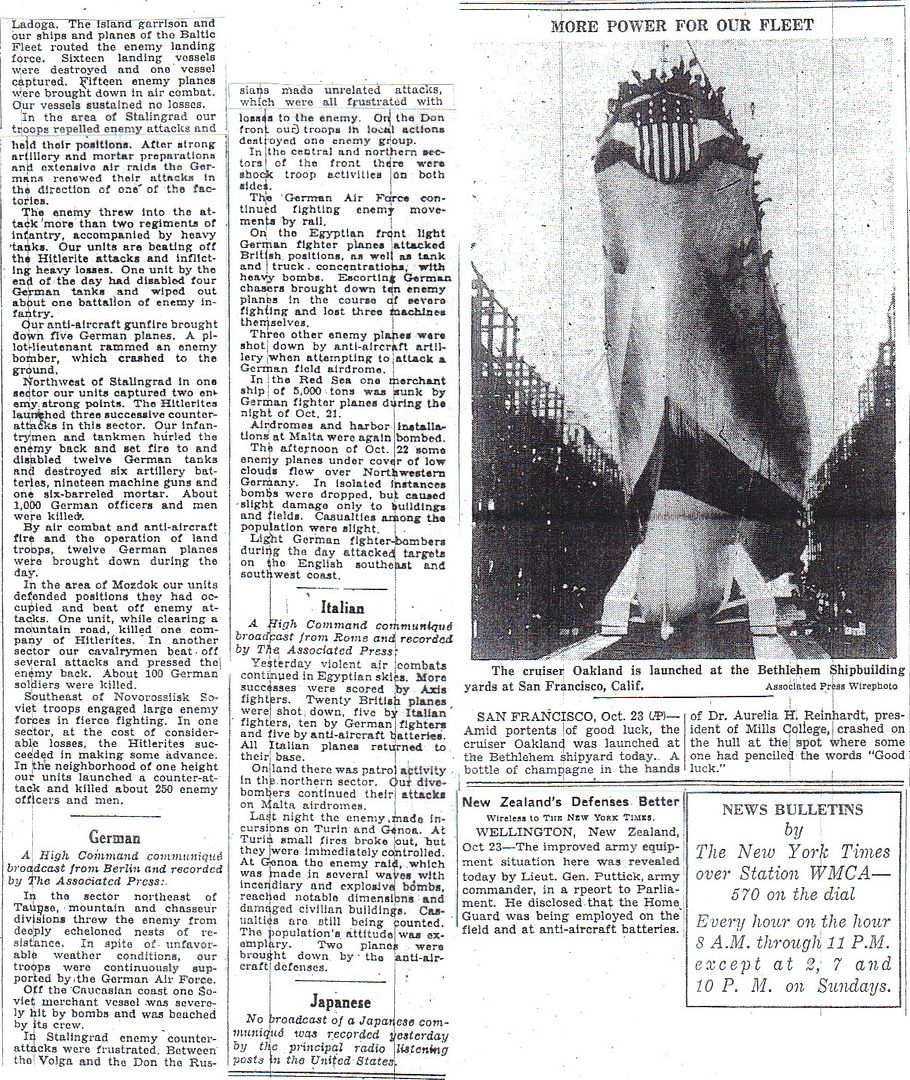
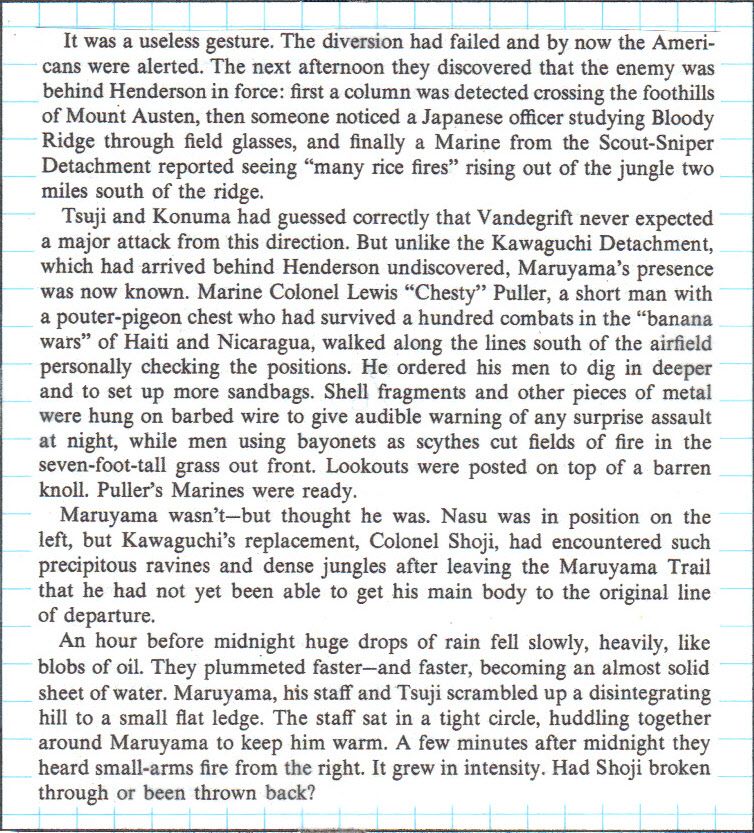
John Toland, The Rising Sun: The Decline and Fall of the Japanese Empire, 1936-1945
http://www.onwar.com/chrono/1942/oct42/f24oct42.htm
US Marines hold off Japanese assault
Saturday, October 24, 1942 www.onwar.com
In the Solomon Islands... On Guadalcanal, heavy fighting continues as the Japanese offensive gains some success with the secondary operations infiltrating the left wing of the America positions. The main operation against the south of the American perimeter begins at dusk and continues throughout the night. It is repelled.
In Berlin... In Germany for medical treatment, Rommel receives word of the British attack and the need for him to return quickly to Africa.
http://homepage.ntlworld.com/andrew.etherington/frame.htm
October 24th, 1942
UNITED KINGDOM:
Frigate HMS Cuckmere launched.
Minesweeper HMS Friendship launched.
Frigate HMS Wear commissioned.
Destroyer HMS Haydon commissioned. (Dave Shirlaw)
GERMANY:
U-244 laid down.
U-276 launched.
U-230, U-732 commissioned. (Dave Shirlaw)
ITALY: Italian targets have been hit for the first time by British-based RAF Lancaster bombers (Whitley’s first bombed Italy, staging through the Channel Islands in 1940). Last night 100 Lancasters attacked Genoa, and today a total of 112 machines flew below barrage balloons to hit Milan in day light. Tonight further raids are planned for targets in the Milan/Genoa/Turin triangle.
This prolonged assault is to coincide with the Eighth Army’s offensive at El Alamein. A Lancaster pilot said later: “We crossed the Channel at almost zero altitude and over France in one enormous mass at 50 feet. The French waved to us.” They flew over the Alps below the summit of Mont Blanc, found Italy under cloud and emerged through this at 4,000 feet over Milan railway station. Another crew flew over the football stadium at half-time, the ball clearly visible in the net alongside orange peel. When they released their 4,000-pound “cookies” there was panic below them. One pilot described hitting a factory: “That’s a factory, that was.” The sun was setting over the Alps as they began the 750-mile flight home.
Only three of the force were shot down: proof for some that the tactic of flying low, in tight formation, is a recipe for success on daylight missions, despite the lack of firepower on the Lancasters.
NORTH AFRICA: Around midnight last night, General Montgomery and the 195,000 Allied troops of the British 8th Army begin their long awaited attack against German positions and Field Marshal Rommel. Montgomery has overseen meticulous preparation for this attack. Complicated measures for deception; extensive preparation for artillery bombardments; and training in night movements mark his preparation. The XXX Corps will push its infantry through the minefields; X Corps with 2 Armoured Divisions will follow and hold off counterattacks while the infantry widens the hole in the German line. In the final phase, the armour will finish off the German Armour. The British hold a 2:1 advantage in tanks, men, guns and air support. The German armour is grouped in two areas due to lack of fuel. German and Italian units have been mixed on the line by Rommel to provide reliable German contingent everywhere.
The initial British attack is by four infantry divisions of XXX Corps abreast on a narrow front (2 NZ, 51 Highland, 9 Aust and 3 South African). There is plenty of artillery support and tactical surprise. But they encounter very thick minefields and well prepared Axis positions.
The German 164th and Italian Trento Divisions with support from the 15th Panzer and Littorio receive the main attack. British forces do not achieve their objectives but are not far short. Rommel is in Germany and General Stumme is in command. During a visit to the front, Stumme dies of a heart attack.
The German reaction to the attack is delayed and inconsistent. Rommel receives word of the attack in the afternoon and makes plans for an immediate return to the front.
El Alamein: In the desert night the troops braced themselves for the greatest battle yet. Some checked their weapons for the hundredth time that day, some played cards in the brilliant moonlight, officers glanced at their watches. Some men prayed.
At 9.40 precisely last night, the desert silence was rent by the crash of 1,000 heavy guns, so powerful that the ground shook under the feet of the engineers who moved forward into the “devil’s garden” - Rommel’s five-mile-deep minefields - clearing lanes and marking them with white tape.
The first barrage lasted for 15 minutes. For a few seconds before 10pm the skirl of bagpipes could be heard down the lines before an even more intensive bombardment opened up. This was the cue for the infantry to begin its advance with the 51st Highland, 1st South African and New Zealand Divisions, their bayonets fixed, going forward at a steady 75 strides a minute to clear the way for the waiting armoured divisions. The speed of the Highlanders’ advance brought them under fire from their own artillery as well as the Germans’. Casualties were high, but they managed to storm their first objective, the heavily-defended Miteiriya Ridge.
Lieutenant-General Montgomery had no option but to make a direct frontal assault. The impassable Qattara Depression precludes any question of an encircling operation. The 9th Australian Division is preparing for a tough fight in the north. The Indian 44th Division is fighting a diversionary battle in the south.
Everything depends on the tanks of XXX Corps, new Grants and Shermans, breaking through. But so many tanks are trying to get through that a massive traffic snarlup is blocking the lanes, a perfect target for German artillery. Sharp words were spoken in “Monty’s” caravan later in the day before the tanks moved again.
By 0700 Freyberg (GOC 2 NZ Div) feels that the armoured breakout is still possible, but only if “a supreme and immediate effort were made.” He recced the routes and makes the plan himself - X Corps’ 8th armoured brigade is behind him and in position to make the break out, while Freyberg’s own 9th armoured brigade will open the way. X Corps and its division commanders dithered, then decided that more support was needed for such an attack to be assured of success. The opportunity slips away.
Montgomery was angry with his armoured commanders. During the day (24 October) he issued orders for the infantry divisions to advance the short distance left to their original objectives and hold, while X Armoured Corps was again to push through them and break out. The Infantry did their bit but X Corps did not. The armoured columns became hopelessly congested whilst trying to pass the infantry’s lines - this was to be expected, but the aggressive and decisive leadership which could have solved the crisis was conspicuously lacking, from corps level down. (Michael Alexander)
SOLOMON ISLANDS: Guadalcanal: The Japanese attack columns spend the day fighting the jungle. Two more assaults are under way along the Lunga and Tenaru rivers by the Japanese 2nd Infantry Division under the command of General Maruyama. The Japanese have sustained heavy losses, particularly at the hands of the newly-arrived “Americal” division. The main attack south of Henderson Field finally about 10:00 pm isolated units of the main body meet the defence line held by 1st Btn, 7th Marines. The main Japanese attack which was originally scheduled for October 21, then postponed several times has finally started. The main portion of the battle will occur tomorrow.
PACIFIC OCEAN: USS Nautilus (SS-168) sinks a cargo ship at 41-10 N, 141-38 E. (Skip Guidry)
TERRITORY OF ALASKA: ALEUTIAN ISLANDS: The Japanese decide to abandon Agattu and move the troops to Kiska. The Americans are unaware of this, and never know they could have taken the island without a shot. Kiska, however, is being turned into a fortress, with underground bunkers, flak guns, and midget submarine pens.
Three USAAF Eleventh Air Force B-17 Flying Fortresses hit the Japanese-held Kiska Island submarine base; results are not observed; and a weather reconnaissance flight is made over Attu Island. (Jack McKillop)
U.S.A.: Vice Admiral W. F. Halsey relieved Vice Admiral R. L Ghormley as Commander of Naval Forces in the South Pacific. Vice Admiral A. S. Carpender relieved Vice Admiral H. F. Leary as Commander of Naval Forces in the SW Pacific. Admiral Leary took over the task force command of Admiral William S. Pye. In the wake of various situations around Guadalcanal, Adm. Nimitz felt Ghormley was something of a Nervous Nellie and simply not sufficiently aggressive or tactically aware enough to appreciate situations and act accordingly. Contrarily, the charismatic “Bull” Halsey, who since his midshipman days at the Naval Academy had been perceived as notably aggressive almost to a fault, was already well known to most officers and many sailors by reputation (bearing in mind that at that time, most men were experienced regulars) and promptly got the energetic support of anyone under him. Announcement of Halsey’s takeover was met with considerable enthusiasm and a sharp upturn in morale, not only by navymen but also amongst the embattled Marines ashore. The only people who did not welcome the change were senior IJN officers, who also knew of his reputation. (N.B. — In large measure, this aspect lay behind the 1944 decision to put Ozawa and his mostly aircraft-bare carriers and support vessels out as a decoy north of the Philippines, feeling almost certain that Nimitz would take off after them — which he did).
US Navy announced they had attacked the Gilbert and Ellice Islands. (Dave Shirlaw)
Spike Jones and his City Slickers’ record of “Der Fuehrer’s Face” with vocal by Carl Grayson makes it to the Billboard Pop Singles chart The song is from the Walt Disney animated short “In Nutzi Land.”. This is the first of his records to make the charts and it stays there for 10 weeks and rises to Number 3. (Jack McKillop)
Destroyer USS Colahan laid down.
Submarine USS Robalo laid down.
Destroyer USS Daly launched.
Minesweeper USS Pheasant launched.
Submarine USS Snook commissioned.
Destroyer USS Laub commissioned. (Dave Shirlaw)
ATLANTIC OCEAN: An RAF Liberator (Sqdn. 224/G) sinks U-599 northeast of the Azores, at position 46.07N, 17.40W, by depth charges, the third U-boat sunk by the RAF in four days. All crew of 44 are lost. (Alex Gordon)
During battle against convoy OS-42 in the North Atlantic, an escort attacked U-301 and U-620 with depth charges, but the boats sustained no damage.
U-383 sank SS Jon Olafsson.
U-516 sank SS Holmpark. (Dave Shirlaw)
“”King and Queen welcome Mrs. Roosevelt.” King says: Damn, you’re ugly!”
http://www.youtube.com/watch?v=Dnj62cbu4jc
“Der Fuehrer’s Face”
Dugout Doug sure had a good P.R. staff. His air raids make the paper just about every day. I noticed he got a dig in about the Australians a couple of days ago.
Disclaimer: Opinions posted on Free Republic are those of the individual posters and do not necessarily represent the opinion of Free Republic or its management. All materials posted herein are protected by copyright law and the exemption for fair use of copyrighted works.